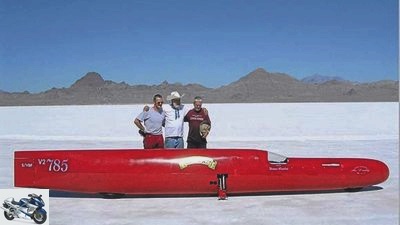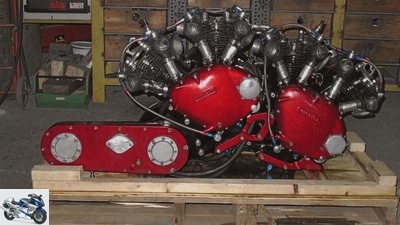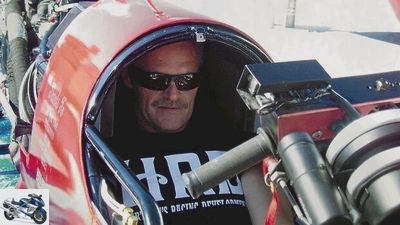Table of contents

Schermer
Sports & scene
Motorsport
World record attempt with Vincent
Scene: World record attempt with Vincent
Hartmut’s Speed Date
Content of
There are stories that don’t even exist: A streamliner with two classic Vincent engines and the German Hartmut Weidelich try to set a world record.
Waldemar Schwarz
04/13/2012
The ink drawing of one hangs on one wall of my office Vincent Black Lightning from 1953 with starting number one: an incredibly beautiful, clear motorcycle with an air-cooled V2, 998 cm³, 70 hp and four-speed gearbox. You can only see a few frames, but the trapezoidal fork, triangular swing arm, 3.00 x 21 tires at the front and 3.50 x 20 at the rear and drum brakes are clearly visible. In the early 50s, the exclusive piece was considered to be the “fastest production motorcycle in the world”. Vincent stated the absolute top speed as “not yet tested”. Brave men got more than 200 km / h out.
Shortly before and for a long time after the Second World War was the great era of world records. Englishmen and Americans fought for the absolute speed record on two, three and four wheels. Of course the Germans were there too, unforgettable Ernst Henne in 1951 with a supercharged BMW on the Frankfurt-Darmstadt autobahn at 274.4 km / h and Wilhelm Herz in 1956 on the Bonneville Salt Flats in Utah on NSU at 339.5 km / h.
Back to Vincent: In 1948 the American Rollie Free set a world record on two wheels on the English Vincent Black Shadow. During the world record run, Rollie was only wearing swimming trunks, a bathing cap and sneakers, because the Vincent had a lot of unrest in the undercarriage due to fluttering clothes and did not run fast enough. The motif “Rollie Free at speed on his Vincent” can be found on many T-shirts and sweaters today.
The current issue is a double Vincent motor, which the American Max Lambky designed as early as 1988, built into a flat cigar and has continued to develop since then. In the first version, the Vincent V2 double had twice 998 cm³ and thus around two liters of displacement. Pure alcohol is used as fuel. A compressor, driven by a 75 mm wide toothed belt, pushes the mixture into the four cylinders. The loader comes from Weiand and is used in everyday life on “small” V8 engines with a displacement of up to four liters. In the two-liter version, the forced-ventilation four-cylinder engine developed around 350 hp.
Year after year, Max Lambky and his friends from the Vincent Owners Club brought the Streamliner to the start of the nine to eleven miles long “Speed Trails” at the Speedweek in Bonneville. But either the competitors were faster or something broke. In 2000, Max put the Streamliner in the wind tunnel of the University of Los Angeles. “400 hp is good for 400 mph,” was the result. The theoretically possible 645 km / h spurred Max on again. In 2004 he brought the two engines to 1500 cm³ each, the output rose to 573 hp.
But it has still not worked out because something kept breaking: the primary tooth chain broke, the rear wheel burst, the compressor shaft broken, all the teeth on the auxiliary shaft sheared off, the entire electrical system dropped out, massive shifting problems, the clutch burned or the mercury safety switch released the brake parachute to name just the most dramatic damage. Once you even forgot to fill up the tank.
In 2004 a German came into play: Hartmut Weidelich, at home in the Swabian-Alemannic town of Aldingen between Rottweil and Tuttlingen. Hartmut is 49 years old today, has been riding two and three-wheelers since he was a child and has been doing cross-team sports regularly for 30 years. The two-wheeler master earns his bread in his own company mainly by repairing and restoring English motorcycles and engines. He has made a name for himself around the world with detailed improvements he developed himself for Vincent engines. That is why Max Lambky brought him into the team as the second driver for the “Vincent Black Lightning Streamliner” project.

Schermer
V2 double of the streamliner.
But the streamliner remained a capricious diva. And after another attempt last year ended with a hole in the piston, Max Lambky wanted to stop and put the Streamliner in the corner for good. The 73-year-old’s state of health was not as stable and money was getting scarcer because there are hardly any sponsors these days. “Stop? – no! ”Hartmut unpacked his Swabian sturdy skull:“ Send me the engine and I will overhaul it professionally, ”he said to Max. The engine came in a wooden box at the beginning of January. Hartmut counted on 200 working hours, but by the end of April it will surely be a good 500 hours.
When the drive then goes back to the USA, it will have had a complete overhaul with countless detail improvements. This affects all the innards of the engine and gearbox, and there is also a new single roller chain with double plates for the primary drive. It all needs to be thought out and worked out. Hartmut does most of the work himself, he has a lot of specialist knowledge and good machine tools. Where his possibilities end, friends step in. This is how Bernhard Spitznagel designed and built the new gearbox. The engines of the specialist, who has been working behind the scenes in the car racing scene for more than 30 years, have already won over 100 German and European championships. Even the centrifugal clutch still has to be reworked, its lining disks come from a Boeing 747. And when everything is ready, the first gear is manually engaged, i.e. by hand on the gearshift lever, before the engine is started, then the electric starter is attached and the engine is started then to babble with infernal noise. The clutch disengages up to around 1500 rpm, then it slowly gains traction and at 3000 rpm it engages completely. The driver gears up by releasing the throttle a little using buttons on the dashboard using compressed air.
When Hartmut Weidelich climbs the Streamliner on the Bonneville Salt Flats towards the end of August and starts a new world record attempt, everything is at stake. When the double V2 it overtakes turns 6500 tours, the following speeds are possible, taking into account five percent slip on the rear wheel: 355 km / h in first gear, 460 km / h in second and 590 km / h in third. The record attempt is registered with the world federation FIM, but with a sidecar. The fastest man on three wheels at the moment is the Swiss tuner legend Fritz W. Egli, who achieved 335 km / h in Bonneville in 2009.
It remains to be seen whether Hartmut Weidelich can top this brand on his Speed Date. My flight Stuttgart-Salt Lake City-Stuttgart in August of this year is already booked, because I absolutely have to do the “BUB Motorcycles Speed Trials 2012” on the salt lake, with all consequences. Without ear plugs, with shorts, a cap on his skull and sunscreen on his skin.
And to get in the mood, I’ll watch the cult film “With Heart and Hands” at least twice, the original title “The World’s Fastest Indian” fits sooo much better. Let’s hope Hartmut Weidelich is as good in reality as actor Anthony Hopkins is as Burt Munro in the film.
Technical specifications

Loving
Hartmut Weidelich takes a first seat sample.
Engine:
Two two-cylinder four-stroke engines coupled via gears, bore 95 mm, stroke 114.3 mm, displacement 2907 cm³, power 573 hp at 6500 rpm, consumption 35 liters of alcohol over 15 km, cooling: cylinder water-cooled, cylinder heads with spray cooling, power transmission : Centrifugal dry clutch, three-speed gearbox, secondary drive via roller chain
Contact:
HRD Dominator Engineering, Hartmut Weidelich, Rottweiler Str. 35, 78554 Aldingen, www.britishclassicbikes.de
Related articles
-
World record ride with an electric motorcycle
fact 15th pictures fact 1/15 How far can an electrically powered series motorcycle go in Drive 24 hours? The Zero S covered 1,316.88 kilometers. That is…
-
Yamaha XS 850 Sudden Wisdom world record with vodka
Montgomery Distillery Sports & scene Yamaha XS 850 Sudden Wisdom world record with vodka Yamaha XS 850 Sudden Wisdom A world record with vodka in the…
-
Elbow-down world record: 160 km-h fast, 30 meters wide
Fresh&Lean 6th pictures Fresh&Lean 1/6 US superbiker Josh Herrin has set a world record in elbow down. Fresh&Lean 2/6 He drove over a distance of 30…
-
Triumph attempted to set a high-speed motorcycle record
markus-jahn.com 21 pictures markus-jahn.com 1/21 Picture gallery: motorcycle high-speed record attempt. markus-jahn.com 2/21 The whole technology is…
-
A record attempt: 48,000 kilometers in 46 days
Sanders 15th pictures Sanders 1/15 The Dalton Highway runs endlessly through the solitude of the Yukon Territory. Sanders 2/15 Gigantic journey in record…
-
Haggling motorcycles Record runs on salt Record runs on salt The fastest place in the world … is just a few miles past the lonely gas station with the…
-
Artist motorcycles Acceleration record attempt Acceleration record attempt Turbo Hayabusa “I’m stamping all your personal bests in,” came the phone. At…
-
Freestyle World Championships in Cologne
Jahn Sports & scene Events Freestyle World Championships in Cologne Sport: Night of the Jumps in Cologne Apollo Cologne Good mood – thanks to a manned…
-
Sport: Superbike World Championship in Buriram-THA
2snap Sports & scene Motorsport Sport: Superbike World Championship in Buriram / THA Sport: Superbike World Championship in Buriram / THA Destination…
-
The most beautiful race track in the world: Bikers Classics in Spa 2012
Hecker 26th pictures Hecker 1/26 The perfect weekend – Bikers Classics in Spa. Hecker 2/26 A fairy in the neighbor’s box: Wendy Newton from California…